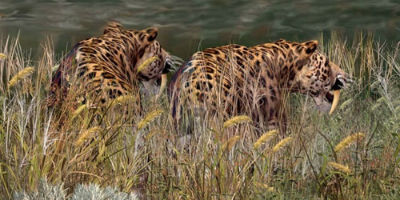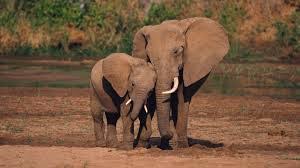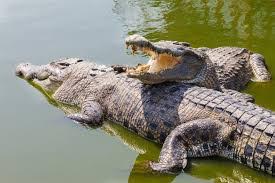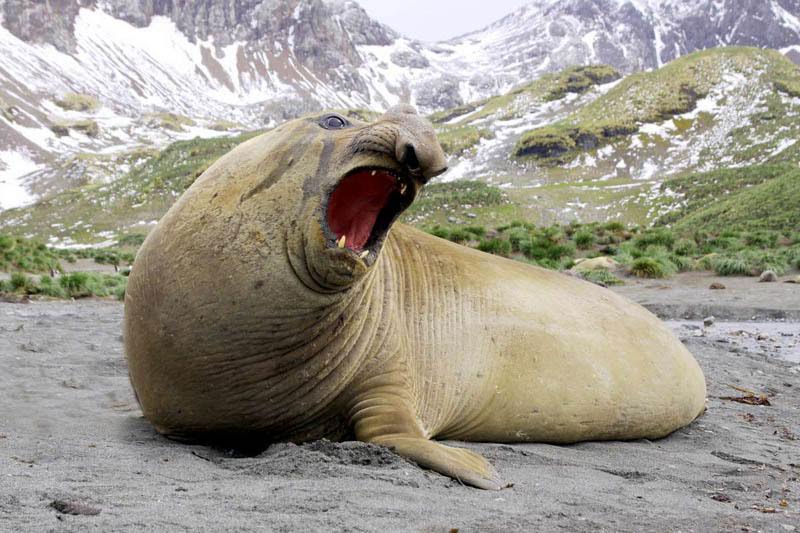 Our world is full of creatures big and small, short and tall.Below the Sifter looks at the largest animals in the world, classified by various categories such as mammals, reptiles, birds, amphibians etc. Some may think the biggest animal is the heaviest, others the longest, or the tallest.
Our world is full of creatures big and small, short and tall.Below the Sifter looks at the largest animals in the world, classified by various categories such as mammals, reptiles, birds, amphibians etc. Some may think the biggest animal is the heaviest, others the longest, or the tallest.Whichever way you measure size there’s no denying that some animals are absolutely huge! Here is a selection of some of the biggest animals on earth.
 Blue Whale
Blue WhaleThe blue whale (Balaenoptera musculus) is a marine mammal belonging to the suborder of baleen whales. At 30 metres (98 ft) in length and 180 metric tons (200 short tons) or more in weight, it is the largest known animal to have ever existed. The Blue Whale’s tongue weighs around 2.7 metric tons (5,952 pounds), about the size of an average Asian Elephant and its heart weighs about 600 kg (1,300 lb) and is the largest known in any animal. Not only is the heart similar size to a mini-cooper car but also comparable in weight.
The Blue Whale is thought to feed almost exclusively on small, shrimp-like creatures called Krill. During the summer feeding season the Blue Whale gorges itself, consuming an astounding 3.6 metric tons (7,900 pounds) or more each day.The whale’s mouth has a fascinating row of plates fringed with bristles to help it filter its main source of food – plankton from the water. There is what looks like a moustache of long bristles on the end of each plate to help it hold the minute prey. With each mouthful, the whale can hold up to 5,000 kg of water and plankton. Having forced the water out of its mouth, the whale licks these bristles with its fleshy tongue. Although the blue whale is a deep-water hunter, as a mammal, it must come to the surface of the sea to breathe. When it surfaces, it exhales air out of a blowhole in a cloud of pressurized vapour that rises vertically above the water for up to 9m. Blue whales occasionally swim in small groups but usually swim alone or in pairs. They are thought to form close attachments.
In spite of their bulk, these graceful swimmers cruise the ocean at over 8km/h, and can reach speeds of over 30km/h.
In spite of their bulk, these graceful swimmers cruise the ocean at over 8km/h, and can reach speeds of over 30km/h.
African Bush Elephant 

The African Bush Elephant is the largest living terrestrial (land) animal, with males reaching 6 to 7.5 metres (19.7 to 24.6 ft) in length, 3.3 metres (10.8 ft) in height at the shoulder, and weighing 6 t (13,000 lb). Females are much smaller, reaching 5.4 to 6.9 metres (17.7 to 22.6 ft) in length, 2.7 metres (8.9 ft) in height at the shoulder, and weighing 3 t (6,600 lb). The adult African bush elephant generally has no natural predators due to its great size, but the calves (especially the newborn) are vulnerable to lion and crocodile attacks, and (rarely) to leopard and hyena attacks.
The elephant brain is the largest of all land mammals, with a mass of over 5 kg. It is similar in structure to the human brain. Like humans elephants must learn important behaviours as they grow up.
African Bush Elephant have amazing memories.The matriarch and fellow senior females remember vital information such as the whereabouts of waterholes which allows elephants to survive in the long dry periods in the plains.
They communicate with each through touch, sound and scent.They use a wide range of sounds to talk to each other, and even communicate at infrasonic levels (which humans can’t hear).African Bush Elephant are able to recognise themselves using mirrors. Self-recognition indicates a very high level of awareness. Only cetaceans, magpies, humans and other primates have so far been found to recognise themselves in mirrors.There is significant evidence to suggest that elephants mourn the passing of conspecifics. They even recognise skulls of other elephants long after they have died, and even with the tusks removed. Elephants gently touch skulls and tusks of dead individuals with their trunks and feet.
Giraffe

African Bush Elephant have amazing memories.The matriarch and fellow senior females remember vital information such as the whereabouts of waterholes which allows elephants to survive in the long dry periods in the plains.
They communicate with each through touch, sound and scent.They use a wide range of sounds to talk to each other, and even communicate at infrasonic levels (which humans can’t hear).African Bush Elephant are able to recognise themselves using mirrors. Self-recognition indicates a very high level of awareness. Only cetaceans, magpies, humans and other primates have so far been found to recognise themselves in mirrors.There is significant evidence to suggest that elephants mourn the passing of conspecifics. They even recognise skulls of other elephants long after they have died, and even with the tusks removed. Elephants gently touch skulls and tusks of dead individuals with their trunks and feet.
Giraffe

Giraffes are the tallest mammal in the world. Their long legs and necks help them to eat leaves at the top of tall trees that other animals cannot reach. It stands 5–6 m (16–20 ft) tall and has an average weight of 1,600 kg (3,500 lb) for males and 830 kg (1,800 lb) for females. The giraffe has an extremely elongated neck, which can be over 2 m (6 ft 7 in) in length, accounting for nearly half of the animal’s vertical height. They have long tongues, and no teeth at the front of their top jaw, which helps them to rip leaves from branches. Male giraffes use their necks for fighting, swinging them from side to side to headbutt their opponent.
The long legs and necks of giraffes make them tallest of all the mammals; at around six foot, the legs alone are taller than many humans. They have a distinct spotted coat, with no two giraffes having the exact same pattern. This means that giraffes can be individually identified from their coats, a feature that is often used in the study of wild giraffe populations.Giraffes inhabit the open plains, grasslands, and savannas of Africa. They are most common in southern and eastern Africa, but some smaller more isolated populations live in western and central Africa.Giraffes inhabit the open plains, grasslands, and savannas of Africa. They are most common in southern and eastern Africa, but some smaller more isolated populations live in western and central Africa.
Polar Bear and Kodiak Bear
The long legs and necks of giraffes make them tallest of all the mammals; at around six foot, the legs alone are taller than many humans. They have a distinct spotted coat, with no two giraffes having the exact same pattern. This means that giraffes can be individually identified from their coats, a feature that is often used in the study of wild giraffe populations.Giraffes inhabit the open plains, grasslands, and savannas of Africa. They are most common in southern and eastern Africa, but some smaller more isolated populations live in western and central Africa.Giraffes inhabit the open plains, grasslands, and savannas of Africa. They are most common in southern and eastern Africa, but some smaller more isolated populations live in western and central Africa.
Polar Bear and Kodiak Bear

The largest living land carnivores are the Polar Bear (Ursus maritimus) and the kodiak bear, a Brown Bear (Ursus arctos) subspecies. Since they have similar body sizes, it is not clear which is definitively larger. In both species, shoulder height has been measured at more than 1.6 m (5.2 ft) and total length at as much as to 3.05 m (10.0 ft). The heaviest polar and brown bear weights recorded were respectively 1,003 kg (2,210 lb) and 1,135 kg (2,500 lb).
Bears are extraordinarily intelligent animals. They have far superior navigation skills to humans; excellent memories; large brain to body ratio; and use tools in various contexts from play to hunting.
Bears grieve deeply for others. Cubs are known to moan and cry when separated from their mothers. This can go on for weeks if their mothers are killed by hunters.
Bears have excellent senses of smell, sight and hearing. They can smell food, cubs, a mate or predators from miles away. Their great eyesight allows them to detect when fruits are ripe.Some species of Asiatic bear build nests in the trees. They can use these for hiding, eating and even sleeping. Bears care deeply about family members. They will risk their lives and even fight to the death in order to save a cub or sibling from danger. Bears were often honoured in the cultures of many early civilisations.They were seen as a symbol of power, strength and love.Vikings and the Celts have many legends about the strength, protectiveness and prowess of bears. The bear is a common national personification for Russia (and the former USSR) and Germany. The brown bear is Finland’s national animal.
Saltwater Crocodile
Bears are extraordinarily intelligent animals. They have far superior navigation skills to humans; excellent memories; large brain to body ratio; and use tools in various contexts from play to hunting.
Bears grieve deeply for others. Cubs are known to moan and cry when separated from their mothers. This can go on for weeks if their mothers are killed by hunters.
Bears have excellent senses of smell, sight and hearing. They can smell food, cubs, a mate or predators from miles away. Their great eyesight allows them to detect when fruits are ripe.Some species of Asiatic bear build nests in the trees. They can use these for hiding, eating and even sleeping. Bears care deeply about family members. They will risk their lives and even fight to the death in order to save a cub or sibling from danger. Bears were often honoured in the cultures of many early civilisations.They were seen as a symbol of power, strength and love.Vikings and the Celts have many legends about the strength, protectiveness and prowess of bears. The bear is a common national personification for Russia (and the former USSR) and Germany. The brown bear is Finland’s national animal.
Saltwater Crocodile

The saltwater crocodile (Crocodylus porosus), is the largest of all living reptiles. It is found in suitable habitats from Northern Australia through Southeast Asia to the eastern coast of India. An adult male saltwater crocodile’s weight is 409 to 1,000 kilograms (900–2,200 lb) and length is normally 4.1 to 5.5 metres (13–18 ft). However, mature males can exceed 6 metres (20 ft) and weigh more than 1,000 kilograms (2,200 lb) and this species is the only extant crocodilian to regularly reach or exceed 4.8 metres (16 ft). The saltwater crocodile is an opportunistic apex predator capable of taking nearly any animal that enters its territory,either in the water or on dry land.The name saltwater crocodile is misleading. They can live in brackish waters along the coastline as well as in freshwater rivers and swamps.Saltwater Crocodiles raise their young in freshwater areas.
Between November and March, the female lays 40 – 60 eggs in a nest made from plant matter and mud on a river bank.The locations of Australian crocodile nests are sometimes used as an indication of how much rain can be expected during the oncoming wet season. Unfortunately, crocodiles don’t always get it right. Many nests are flooded every year, killing the embryos.The eggs take 90 days to develop. The sex of the young saltwater crocodiles is determined by the incubation temperature. Below 30oC the hatchlings will be female, and above 32oC they will be male.When saltwater crocodiles are about to hatch they make chirping sounds from within their eggs. Their mother then helps them by digging them out of the nest. Once they are hatched she takes them to the water’s edge in her mouth and from here on watches over them until they are able to look after themselves.
Ostrich

The flightless ostrich is the world’s largest bird. Ostriches have three stomachs. Unlike all other living birds, the ostrich secretes urine separately from faeces. Ostriches are the fast runners of any birds or other two-legged animal and can sprint at over 70 km/hr, covering up to 5m in a single stride. Ostriches’ running is aided by having just two toes on each foot (most birds have four), with the large nail on the larger, inner toe resembling a hoof.
Ostriches’ wings reach a span of about 2 metres and are used in mating displays, to shade chicks, to cover the naked skin of the upper legs and flanks to conserve heat, and as “rudders” to help them change direction while running.When threatened ostriches run although their powerful, long legs can be formidable weapons, capable of killing a human or a potential predator like a lion with a forward kick.
Ostriches normally spend the winter months in pairs or alone and during breeding season and sometimes during extreme rainless periods they live in nomadic ‘herds’ of five to 50 birds led by a top hen, that often travel together with other grazing animals, such as zebras or antelopes. Territorial fights between males for a harem of two to seven females usually last just minutes, but they can easily cause death through slamming their heads into opponents. Ostriches perform a complex mating ritual consisting of the cock alternating wing beats until he attracts a mate, when they will go to the mating area and he will drive away all intruders. They graze until their behaviour is synchronized, then the feeding becomes secondary and the process takes on a ritualistic appearance. The cock will then excitedly flap alternate wings again, and start poking on the ground with his bill. He will then violently flap his wings to symbolically clear out a nest in the dirt. Then, while the hen runs circle around him with lowered wings, he will wind his head in a spiral motion. She will drop to the ground and he will mount for copulation.
Southern Elephant Seal
Between November and March, the female lays 40 – 60 eggs in a nest made from plant matter and mud on a river bank.The locations of Australian crocodile nests are sometimes used as an indication of how much rain can be expected during the oncoming wet season. Unfortunately, crocodiles don’t always get it right. Many nests are flooded every year, killing the embryos.The eggs take 90 days to develop. The sex of the young saltwater crocodiles is determined by the incubation temperature. Below 30oC the hatchlings will be female, and above 32oC they will be male.When saltwater crocodiles are about to hatch they make chirping sounds from within their eggs. Their mother then helps them by digging them out of the nest. Once they are hatched she takes them to the water’s edge in her mouth and from here on watches over them until they are able to look after themselves.
Ostrich

The flightless ostrich is the world’s largest bird. Ostriches have three stomachs. Unlike all other living birds, the ostrich secretes urine separately from faeces. Ostriches are the fast runners of any birds or other two-legged animal and can sprint at over 70 km/hr, covering up to 5m in a single stride. Ostriches’ running is aided by having just two toes on each foot (most birds have four), with the large nail on the larger, inner toe resembling a hoof.
Ostriches’ wings reach a span of about 2 metres and are used in mating displays, to shade chicks, to cover the naked skin of the upper legs and flanks to conserve heat, and as “rudders” to help them change direction while running.When threatened ostriches run although their powerful, long legs can be formidable weapons, capable of killing a human or a potential predator like a lion with a forward kick.
Ostriches normally spend the winter months in pairs or alone and during breeding season and sometimes during extreme rainless periods they live in nomadic ‘herds’ of five to 50 birds led by a top hen, that often travel together with other grazing animals, such as zebras or antelopes. Territorial fights between males for a harem of two to seven females usually last just minutes, but they can easily cause death through slamming their heads into opponents. Ostriches perform a complex mating ritual consisting of the cock alternating wing beats until he attracts a mate, when they will go to the mating area and he will drive away all intruders. They graze until their behaviour is synchronized, then the feeding becomes secondary and the process takes on a ritualistic appearance. The cock will then excitedly flap alternate wings again, and start poking on the ground with his bill. He will then violently flap his wings to symbolically clear out a nest in the dirt. Then, while the hen runs circle around him with lowered wings, he will wind his head in a spiral motion. She will drop to the ground and he will mount for copulation.
Southern Elephant Seal

The Southern elephant seal is the largest carnivore living today. This seals’ size shows extreme sexual dimorphism, possibly the largest of any mammal, with the males typically five to six times heavier than the females. While the females average 400 to 900 kilograms (880 to 2,000 lb) and 2.6 to 3 meters (8.5 to 9.8 ft) long, the bulls average 2,200 to 4,000 kilograms (4,900 to 8,800 lb) and 4.5 to 5.8 meters (15 to 19 ft) long. The record-sized bull, shot in Possession Bay, South Georgia on February 28, 1913, measured 6.85 meters (22.5 ft) long and was estimated to weigh 5,000 kilograms (11,000 lb).Southern elephant seals dive repeatedly, each time for more than twenty minutes, to hunt their prey—squid and fish— at depths of 400 to 1,000 meters (1,300 to 3,300 ft). The documented diving records for the seals are nearly two hours for the duration, and more than 1,400 meters (4,600 ft) in depth.
The diverse order Carnivora includes over 280 species of placental mammals. Its members are formally referred to as carnivorans, while the word “carnivore” (often popularly applied to members of this group) can refer to any meat-eating organism. Carnivorans are the most diverse in size of any mammalian order, ranging from the least weasel (Mustela nivalis), at as little as 25 grams (0.88 oz) and 11 centimetres (4.3 in), to the polar bear and southern elephant seal
The diverse order Carnivora includes over 280 species of placental mammals. Its members are formally referred to as carnivorans, while the word “carnivore” (often popularly applied to members of this group) can refer to any meat-eating organism. Carnivorans are the most diverse in size of any mammalian order, ranging from the least weasel (Mustela nivalis), at as little as 25 grams (0.88 oz) and 11 centimetres (4.3 in), to the polar bear and southern elephant seal












